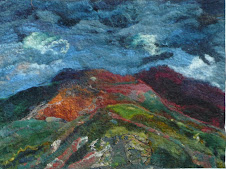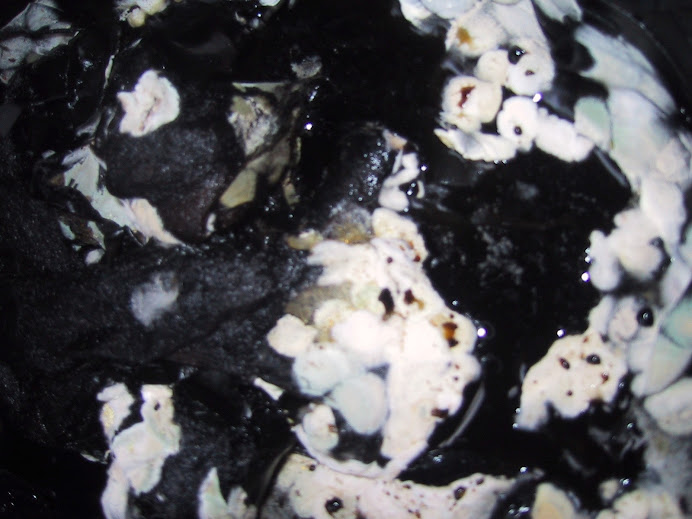I have been eyeing up the purple loostrife bath has been sitting on the floor of the studio for the past week because if not quite the inky black of the eucalyptus bath it is a dark charcoal now. I have been wondering whether the bath is better when it has been left giving the iron time to form the iron tannin complex that I understand gives the black. So today I put in 50g of merino tops and have left it heating gently. If you put a finger and thumb in it feels almost as though the bath is slightly thick and you can rub a black slime between your finger and thumb.
In answer to Leena's comment I have used logwood for black and have a very good recipe which Jenny Dean helped me develop and it gives an excellent black with iron ( I used it in my picture Rising Sun ) but I need a black for my medieval hat maker who can't use logwood and also because I want to see whether I can get the colours you are supposed to be able to get from such plants as Pl and elecampane. My final reason that my dye garden will be opened next year and I want a sample of every dye plant in the garden. My work may be cut out as Enys who does the garden has gone to America is meeting up with a professor of a botanical garden with a view to getting exotic seeds The dark green sounds very interesting and I shall try that as a dark green is so useful. Thanks Leena
In the meantime I decided so see whether I could get hold of any alder bark, none of my suppliers seemto have it, but my eye was caught by alderbuckthorn (Frangulaa Alnus)Much excited I looked up the name and found it is a variety of buckthorn not an alder and is not a dye I have used very much. As I browsed through the pages I found you could ferment the mature berries of buckthorn for a lightfast purple At this moment my thoughts digressed and I found myself remembering a time not so long either when I thought I knew a lot about natural dyeing. Now the more I do the less I seem to know. Anyway that is a digression . On reading about alder buckthorn I was interested to find that if fermented in beechwood ash lye it would give a madder type red. I dived into my dye box and found at the bottom a kilo of buckthorn bark-then I discovered you could do the same recipes with buckthorn bark as for alderbuckthorn So Dye bath 1 is 200g of buckthorn chips which I put into soak. The water went bright yellow immediately. Dyebath 2 is 200g of buckthorn covered with woodash lye.-2.2litres. This I then heated to 50degrees C hauled out a hot plate and placed it on it as the recipe said to cover the chips with warm wood ash lye ( it should be beech ash but I did not have it) for 8 days. This time the liquor turned bright red.
I feel very excited. What is it about creating colour that is so life giving? I just love it. :)
I want to get some alderbuckthorn and also some beech ash for beech ash lye. In fact I can't wait and am racking ny brains for someone who works in beech.
The recipe incidentally came from Dominique Cardons book Natural Dyes which represents for me £75.00 very well spent even if the chemistry is mostly over my head!
Inadvertently Monochromatic Photos
-
Recently it's felt both busy and so slow! We've had snow squalls and
storms arriving early this year. We've had Alberta Clippers coming in off
the lak...
3 days ago



























I feel totally the same way that more I find out about natural dyes, the less I seem to know! Always new things come out and there are new (for me) techniques to try out.
ReplyDeleteAbout beech ash lye, in old Finnish recipes, they told to use birch ash lye as an afterbath to change the hue of the color so it came to me that maybe anything decidous tree ash works. In Finland birch is the most common decidous tree cut for firewood and its ashes were easily obtainable so I thought that maybe with beech it was the same kind of thing with the author of your recipe.
But I don't know, this is just speculation. I am looking forward to seeing the results of your dyes.
I have to wait for a booklet I lent to a friend - about latvian dye recipes and the dye stuff and natural mordants they used! but it seems Leena is right in her observation that people use what's in plentiful supply. there is this dye book from japan, where the master dyer Yoshioka uses the ash of freshly burned camellia leaves instead of alum. of course my small camellias wouldn't give enough leaves in a lifetime, so I will have to make do with other ideas. his book is inspirational and the colours in the photos make me green with envy. I tell myself that of course as a professional dyer his possibilites are far greater (he sometimes dyes with new dye stuff 8-10 times on the same silk, to intensify the colours!)- but it still makes me feel that there is a lot still to learn out there....
ReplyDelete